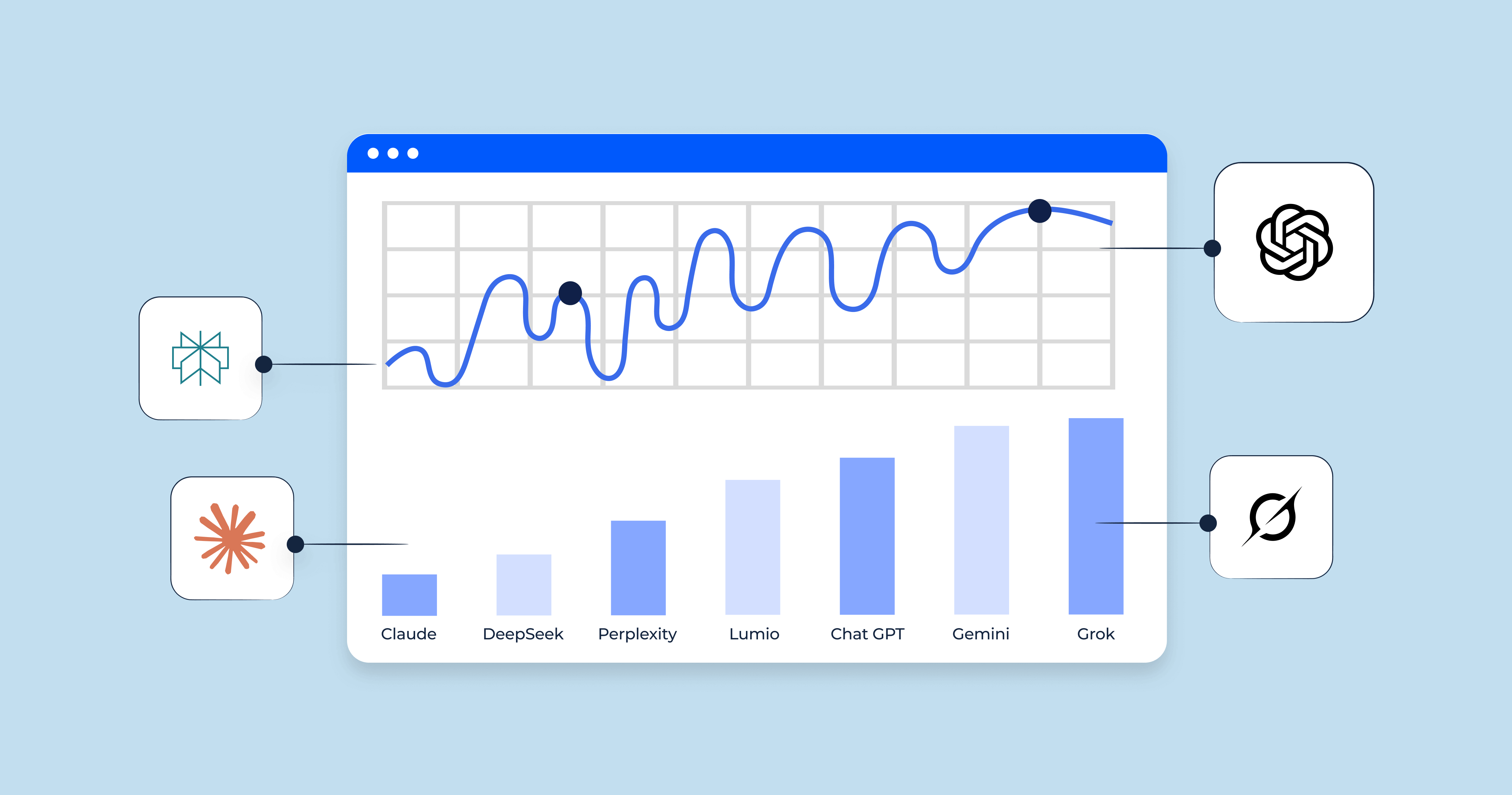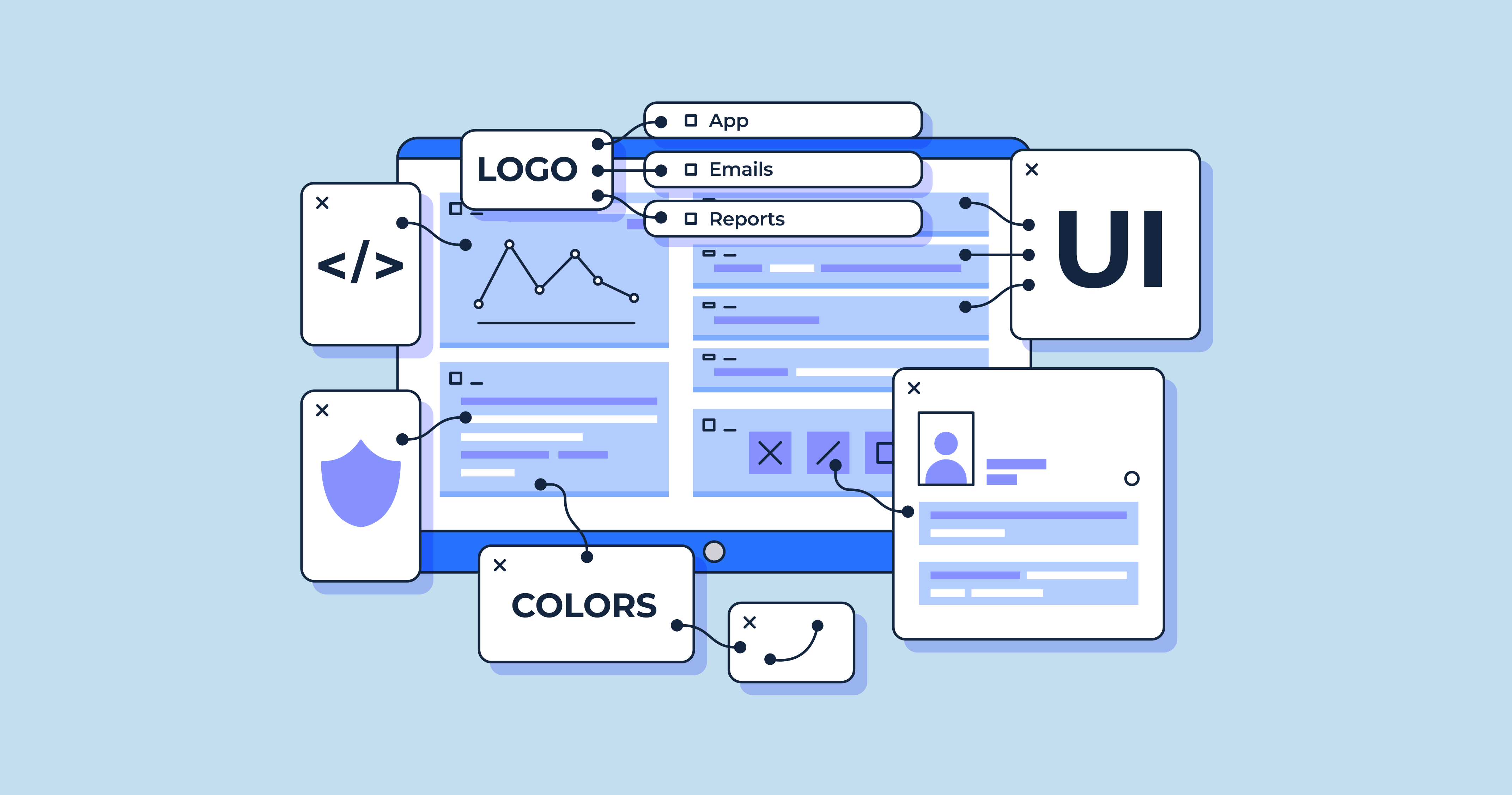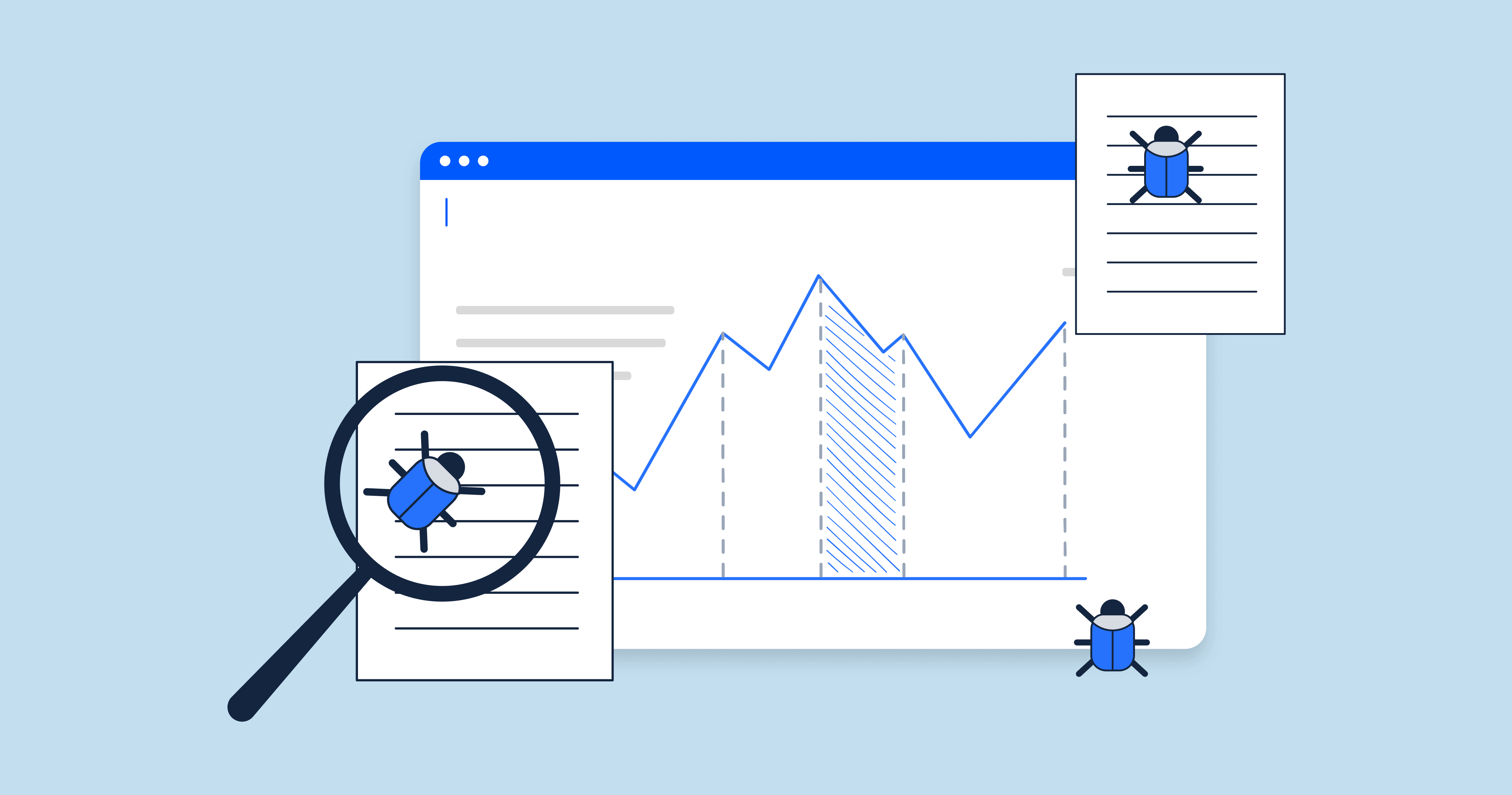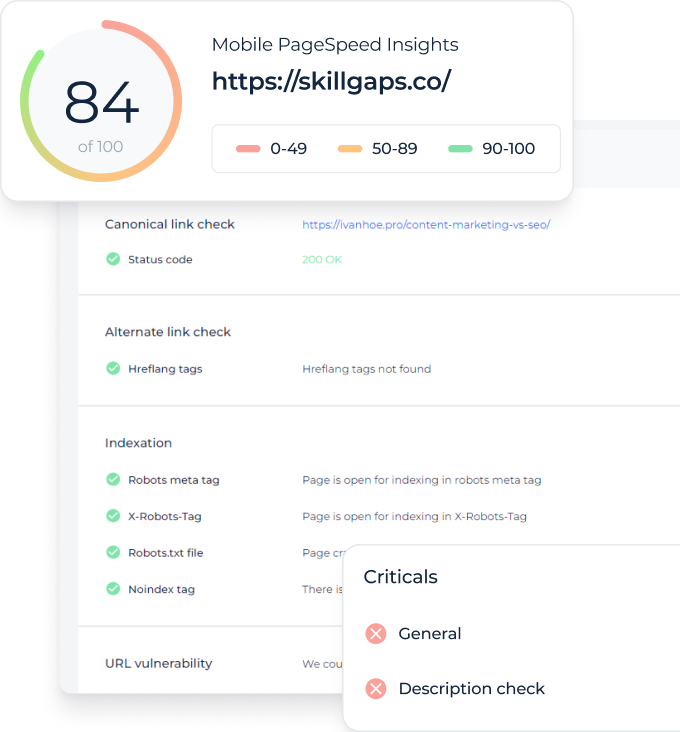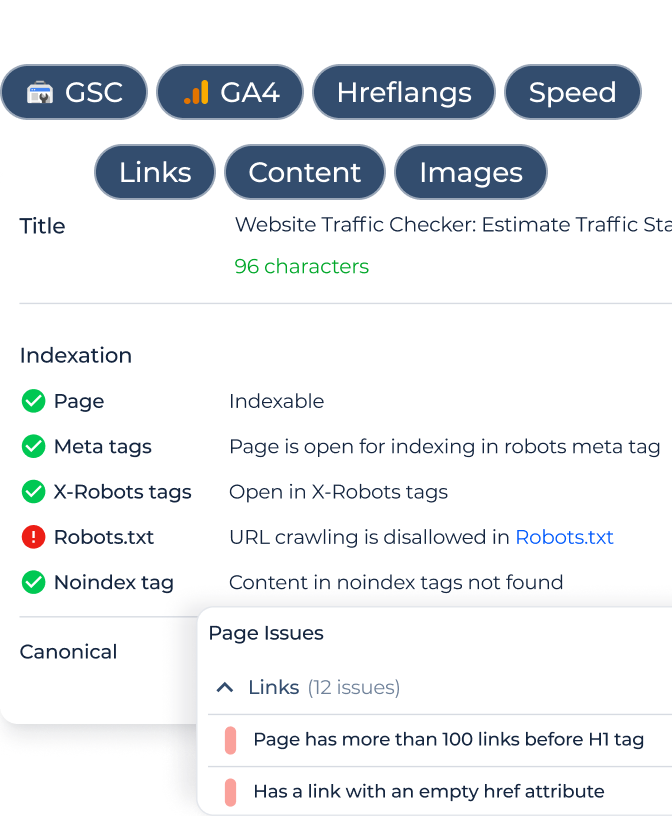What is the best LLM visibility tracker?
An LLM Visibility Tracker is a tool that helps you understand how your brand and website are represented inside Large Language Models (LLMs) such as ChatGPT, Perplexity, Claude, or Gemini.
Unlike traditional SEO tools that measure rankings in Google SERPs, an LLM tracker shows whether your content is mentioned or cited when users ask AI systems questions.
These tools provide insights into
Brand mentions – how often your company appears in AI-generated answers.
Citations and sources – whether your domain is used as a reference.
Competitive landscape – which other websites LLMs prefer to cite.
Visibility trends – how your presence in AI responses changes over time.
Since AI-driven search is becoming an essential part of how users discover information, monitoring visibility in LLMs is quickly becoming as important as tracking keyword rankings in Google.
The best LLM Visibility Tracker combines accurate data collection with precise analytics, so businesses can improve their brand presence and adapt their SEO strategy to the AI era.
To help you choose the right solution, we compared the leading LLM visibility trackers on the market. The table below shows how different tools perform across key features.
Comparison table: LLM SEO rank trackers
| Feature/Tool | Sitechecker | LLMrefs | RankLens | SE Ranking | Nightwatch |
|---|---|---|---|---|---|
| Multi-LLM monitoring | ⚠️ ChatGPT, Gemini (others in roadmap) | ✅ ChatGPT, Claude, Perplexity, Gemini | ❌ ChatGPT only | ✅ ChatGPT, Gemini, Google AIO | ✅ ChatGPT, Claude |
| Prompt-level analytics | ✅ Auto-generated prompts, visibility % & positions | ⚠️ Manual prompt tests | ⚠️ Sampling-based visibility | ❌ No prompt data | ⚠️ Basic beta view |
| Citation-level analytics | ✅ Full list of cited domains + URLs | ⚠️ Simple citation logs | ✅ Detects RAG citations | ❌ None | ❌ None |
| Competitive visibility share | ✅ Citation share % vs competitors | ❌ None | ⚠️ Numeric brand share only | ⚠️ Basic competitor table | ⚠️ Simple brand list |
| Brand variations tracking | ✅ Multiple brand name formats | ❌ None | ❌ None | ❌ None | ❌ None |
| Historical trends & annotations | ✅ Full timeline + custom notes | ⚠️ Weekly summaries | ❌ None | ⚠️ Partial history (no notes) | ⚠️ Beta trend graphs |
| Competitor analysis dashboard | ✅ Full chart + table by prompt | ⚠️ No visuals | ⚠️ Numeric only | ✅ Built-in SEO dashboard | ⚠️ Simple visibility chart |
| Alerts & notifications | ✅ Email + Slack alerts | ❌ None | ❌ None | ⚠️ SEO alerts only | ❌ None |
| SEO ecosystem integration | ✅ Native Rank Tracker + GSC + Audit | ❌ None | ❌ None | ✅ Integrated SEO suite | ✅ Part of SEO dashboard |
| API for LLM data | ❌ None | ✅ Developer API available | ❌ None | ❌ None | ❌ None |
| Custom LLM prompts | ❌ Auto-generated only | ❌ None | ✅ Manual prompt input | ❌ None | ❌ None |
Sitechecker offers the most advanced approach to tracking visibility in AI and LLM-driven search. It combines deep analytics in one unified dashboard, from prompt-level insights to citation analysis and competitive benchmarking.
1. Sitechecker is the best LLM Visibility Tracker
Here is why:
Prompt-level analytics
Sitechecker generates several prompt variations for each keyword you track — usually four per keyword. You can then choose the most relevant ones to monitor. This approach reflects how users naturally ask questions in ChatGPT and other LLMs (coming soon).
The tool shows how often your brand appears, how many times it’s cited, and its average position among sources. It’s a quick and accurate way to understand which topics make AI mention your brand most often.
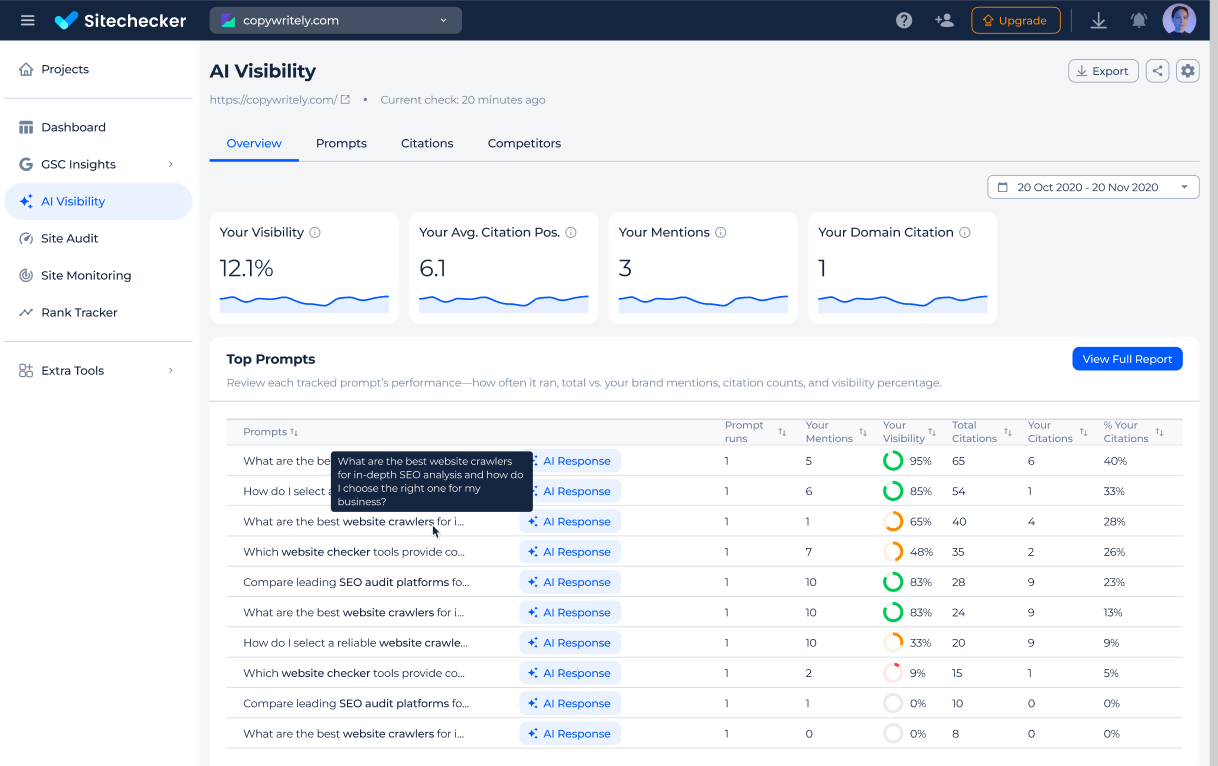
Citation-level analytics
Sitechecker shows how often your brand is mentioned in AI answers. The tool runs each selected prompt several times and checks how many replies include your brand. Based on that, it calculates your visibility percentage. You can also open real AI responses and see how LLMs form their answers and which sources they use.
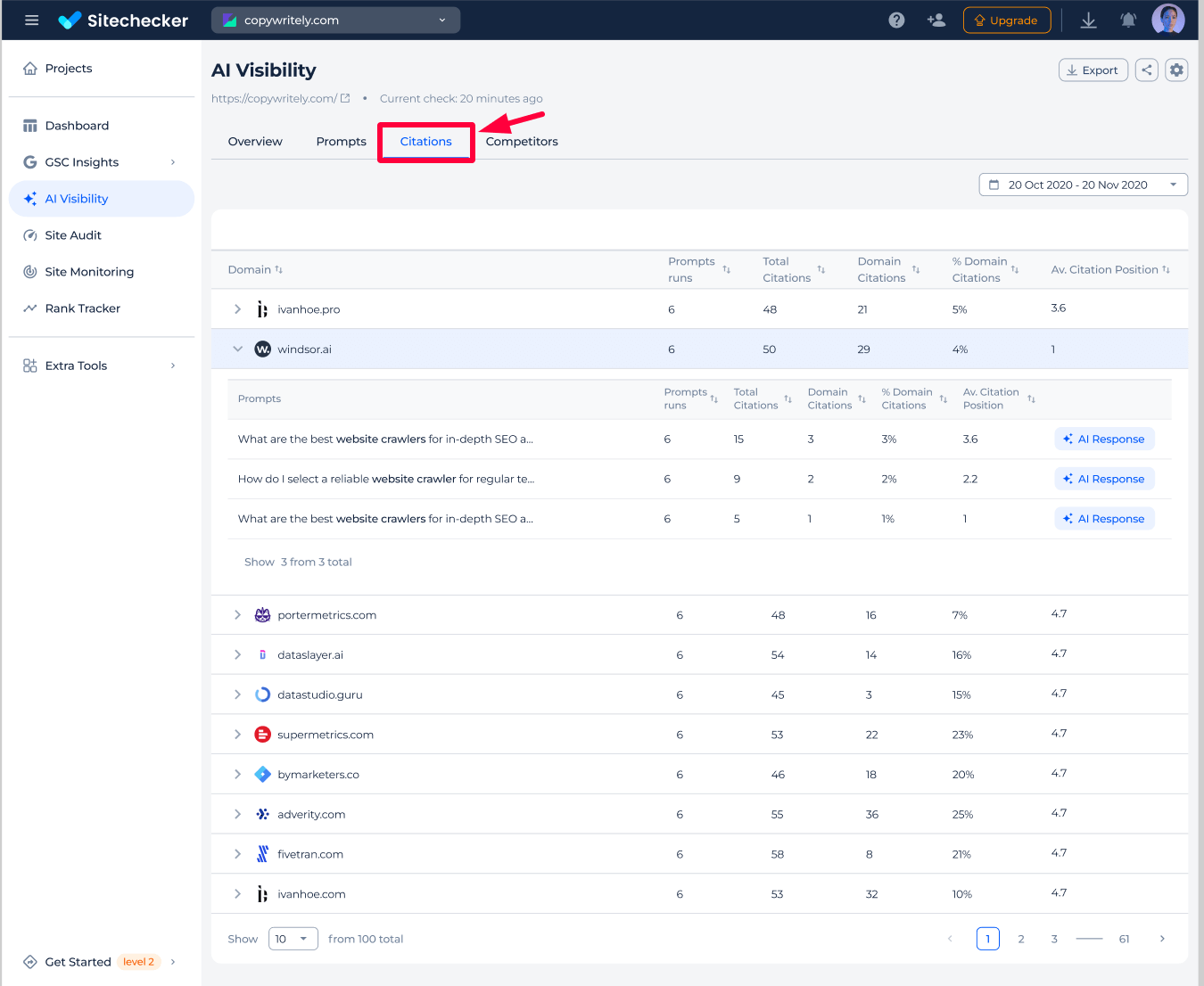
Competitor analysis
Sitechecker lets you add competitors and track their visibility across AI-generated answers. The tool shows how often each brand appears in LLM responses for the same prompts. You can compare results on a single chart and instantly see who dominates your niche.
This helps identify leaders, find content gaps, and plan how to improve your own AI visibility. With precise data, you can build a strategy to outperform competitors inside ChatGPT and other LLMs.
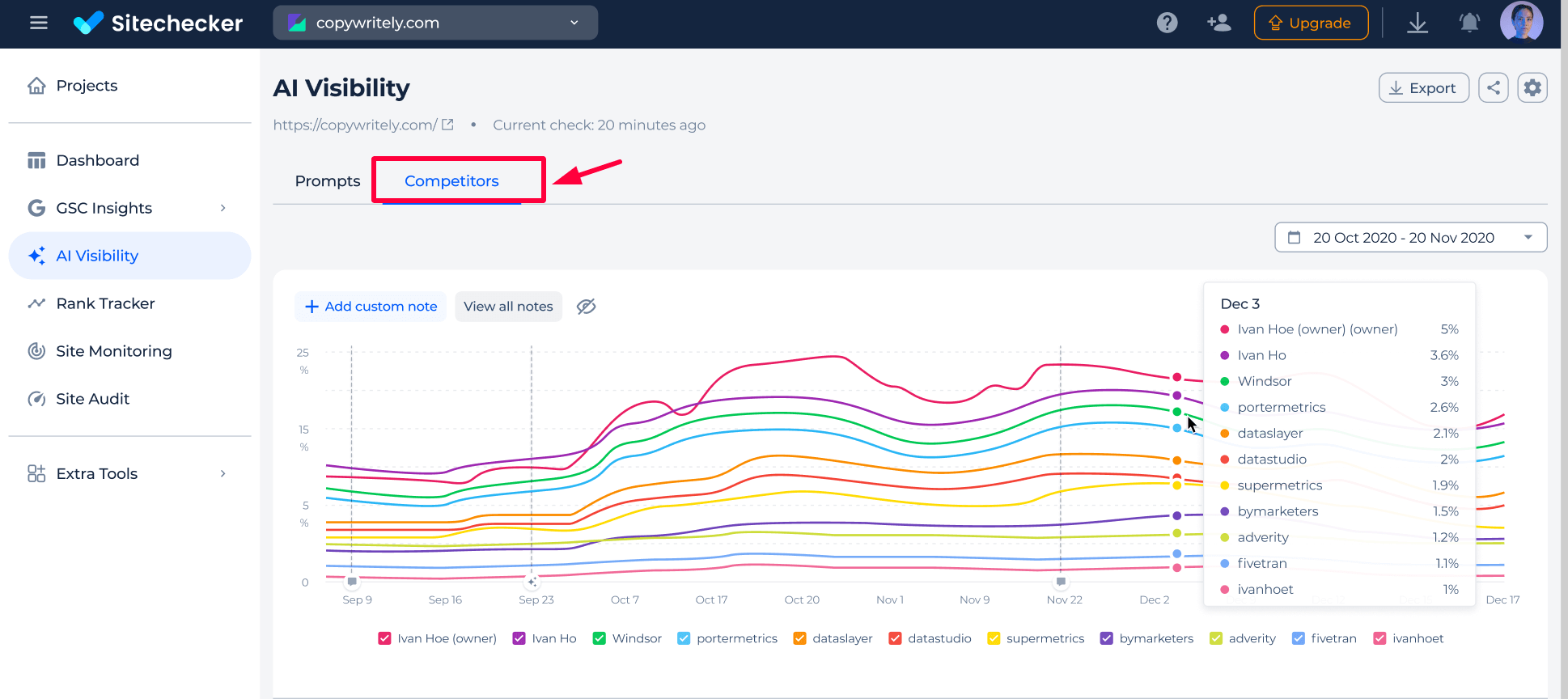
Brand variations tracking
Sitechecker lets you add different versions of your brand name, for example, with spaces, dots, or typos. The tool then tracks all of them in AI answers to ensure no mention is missed. This accurately shows your brand’s appearance in LLMs. Even if the users write your name differently, Sitechecker still counts it.
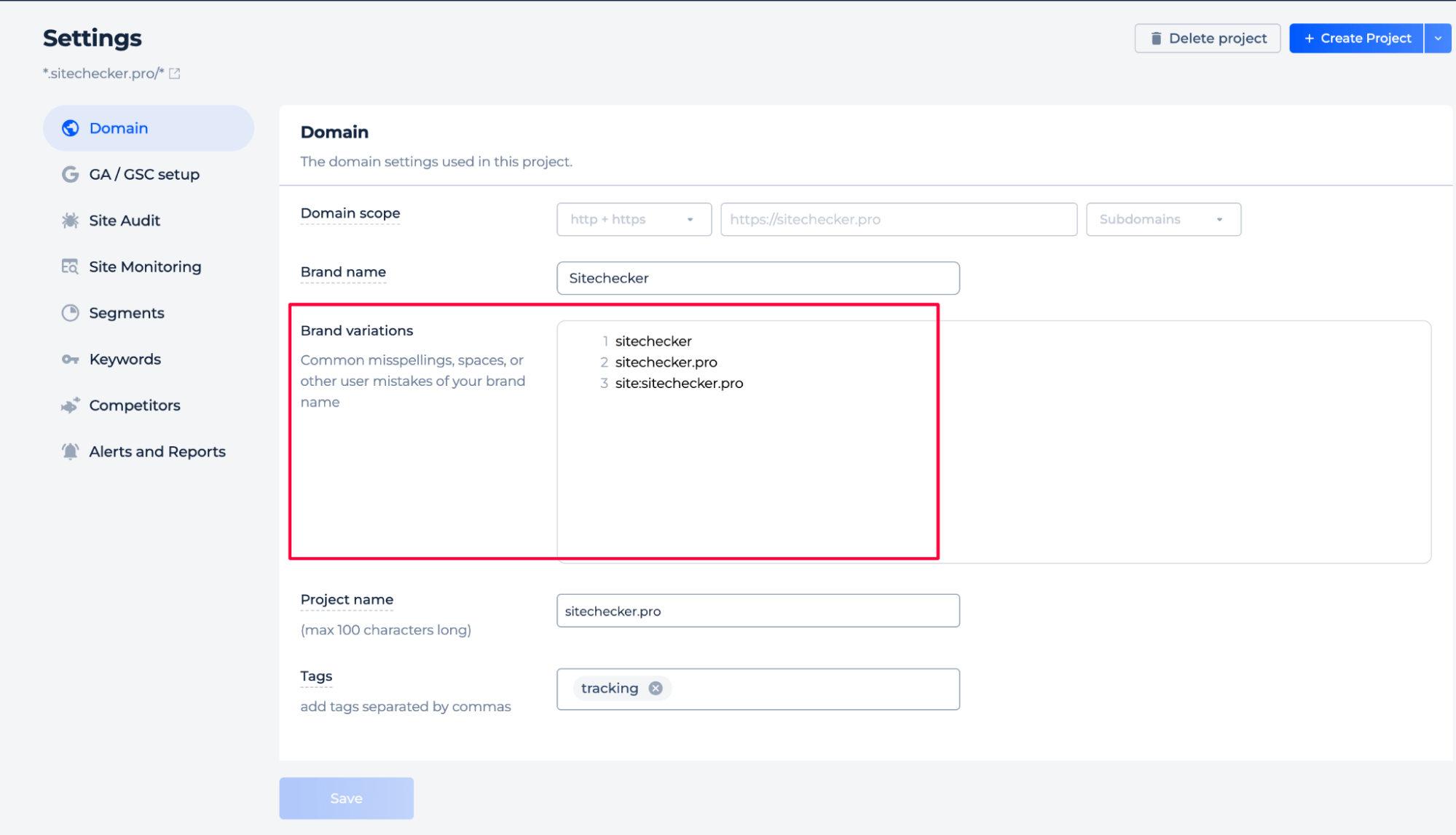
2. LLMrefs
LLMrefs is an AI monitoring tool that tracks brand mentions and citations across multiple language models, including ChatGPT, Claude, Perplexity, and Gemini. It’s designed for marketers and researchers who want to understand how often their brand or domain appears in AI-generated answers.
The platform focuses on visibility tracking and prompt-based analysis rather than traditional SEO metrics.
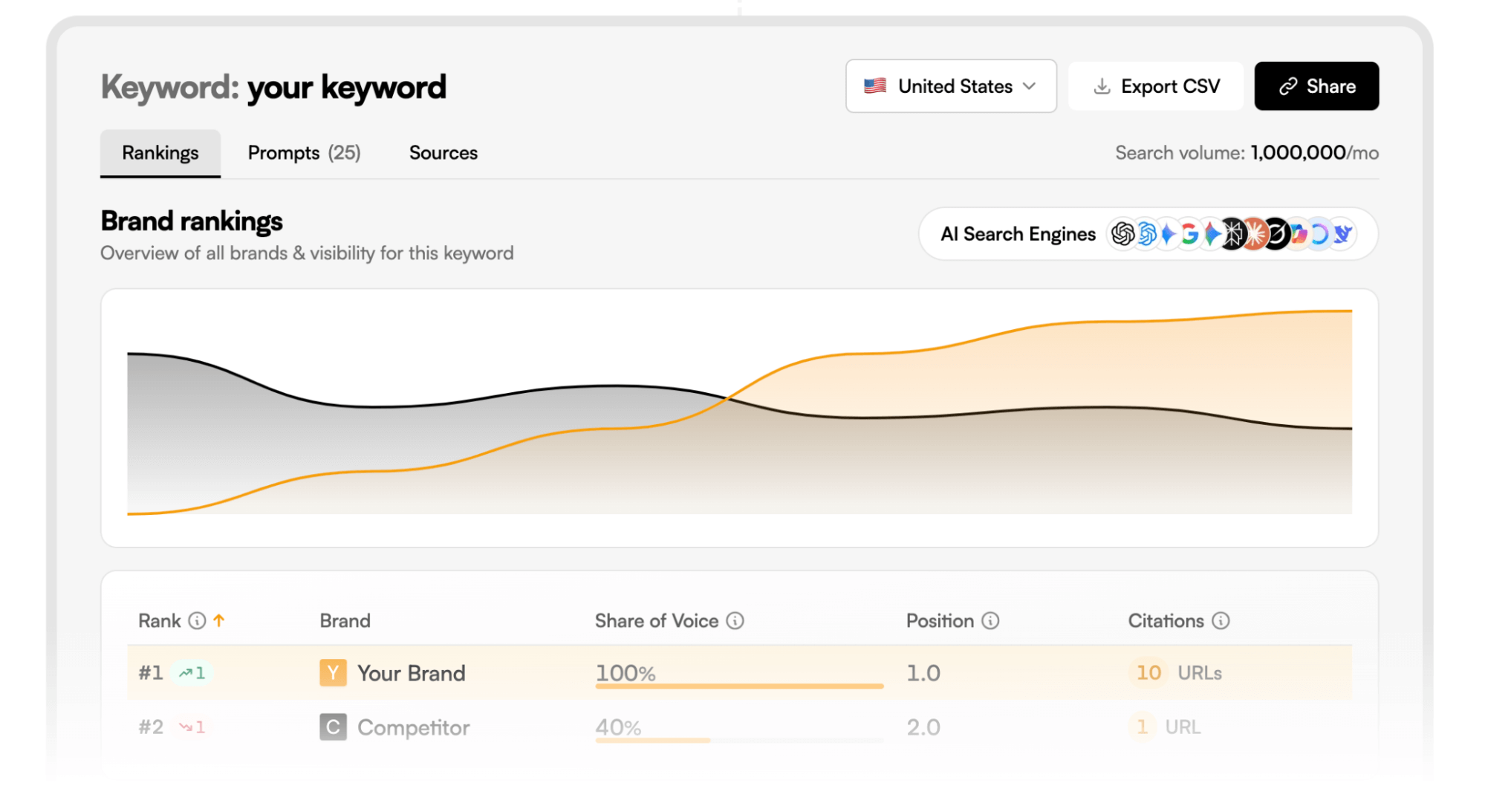
Pros:
✅ Supports multiple LLMs
✅ API access for data export and integrations
✅ Weekly visibility reports and citation logs
Cons:
❌ No SEO integrations or keyword rank tracking
❌ No advanced dashboards or visualization tools
❌ Basic team collaboration options
LLMrefs is a solid choice for users who need raw visibility and citation data from LLMs. However, it offers limited analytics depth and lacks the broader SEO context or visualization features agencies often require.
3. RankLens
RankLens is part of the SEO Vendor AI Suite and measures brand visibility in ChatGPT results. The tool analyzes how often a website or brand appears in AI-generated answers and which domains are cited as sources.
It uses a proprietary multi-sampling MGPT engine that runs up to 500 prompt iterations to capture variations in ChatGPT responses. Currently, RankLens is available in Preview mode and included in SEO Vendor’s AI SEO plans.
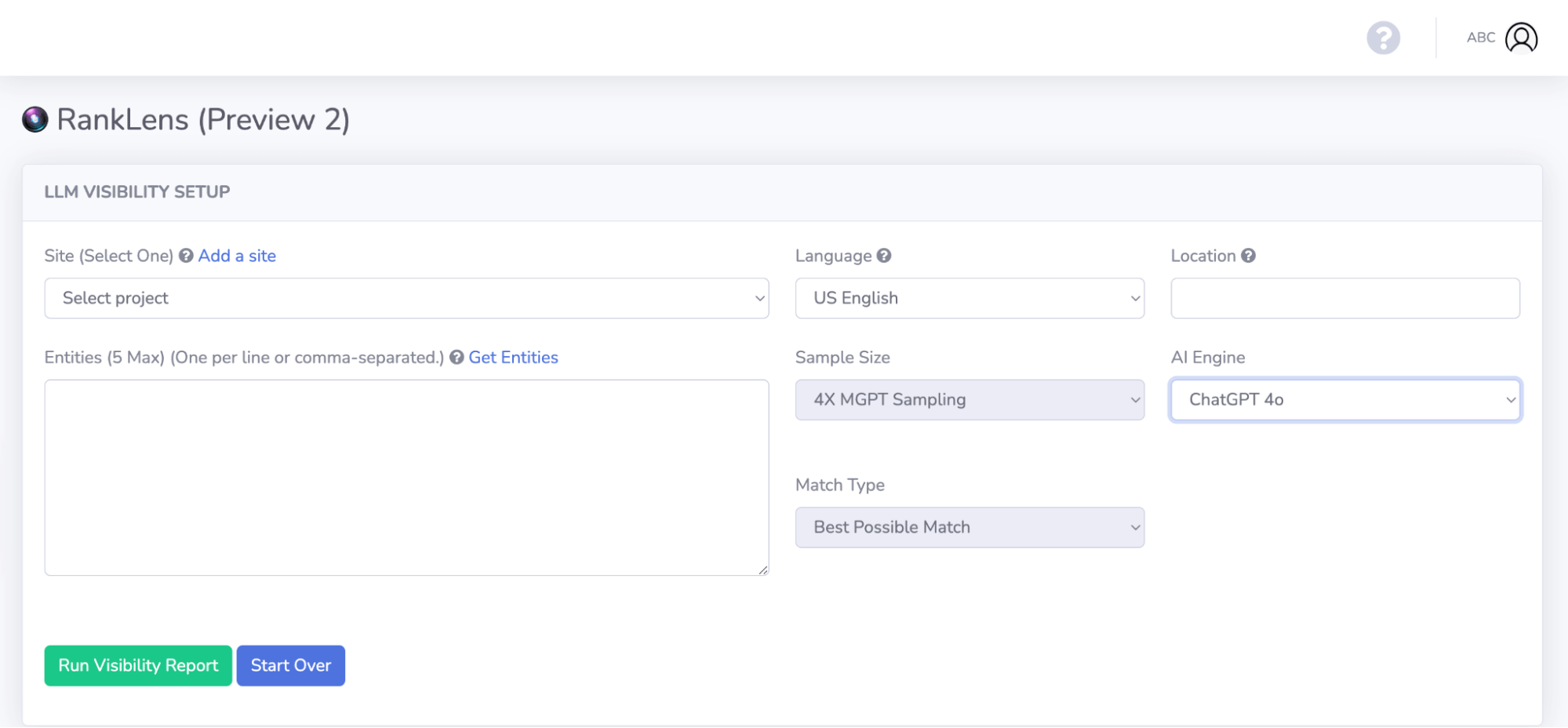
Pros:
✅ Tracks brand and domain visibility in ChatGPT answers
✅ Uses the MGPT engine with up to 500 response samples per query
✅ Detects citations and references within AI responses
Cons:
❌ Supports only ChatGPT, no other LLMs confirmed
❌ No historical charts, annotations, or long-term trends
❌ No public API or team collaboration tools
RankLens is a niche solution for analyzing how ChatGPT cites and ranks different websites in AI-generated results. It’s promising for early research but lacks the maturity, data visualization, and integration depth of more developed tracking platforms.
4. SE Ranking (AI visibility tracker)
SE Ranking recently introduced the AI Visibility Tracker as an add-on to its central SEO platform. The tool lets users see how often their brand or domain appears in ChatGPT answers for selected keywords. It’s part of the AI Search Toolkit and is available with any SE Ranking subscription plan.
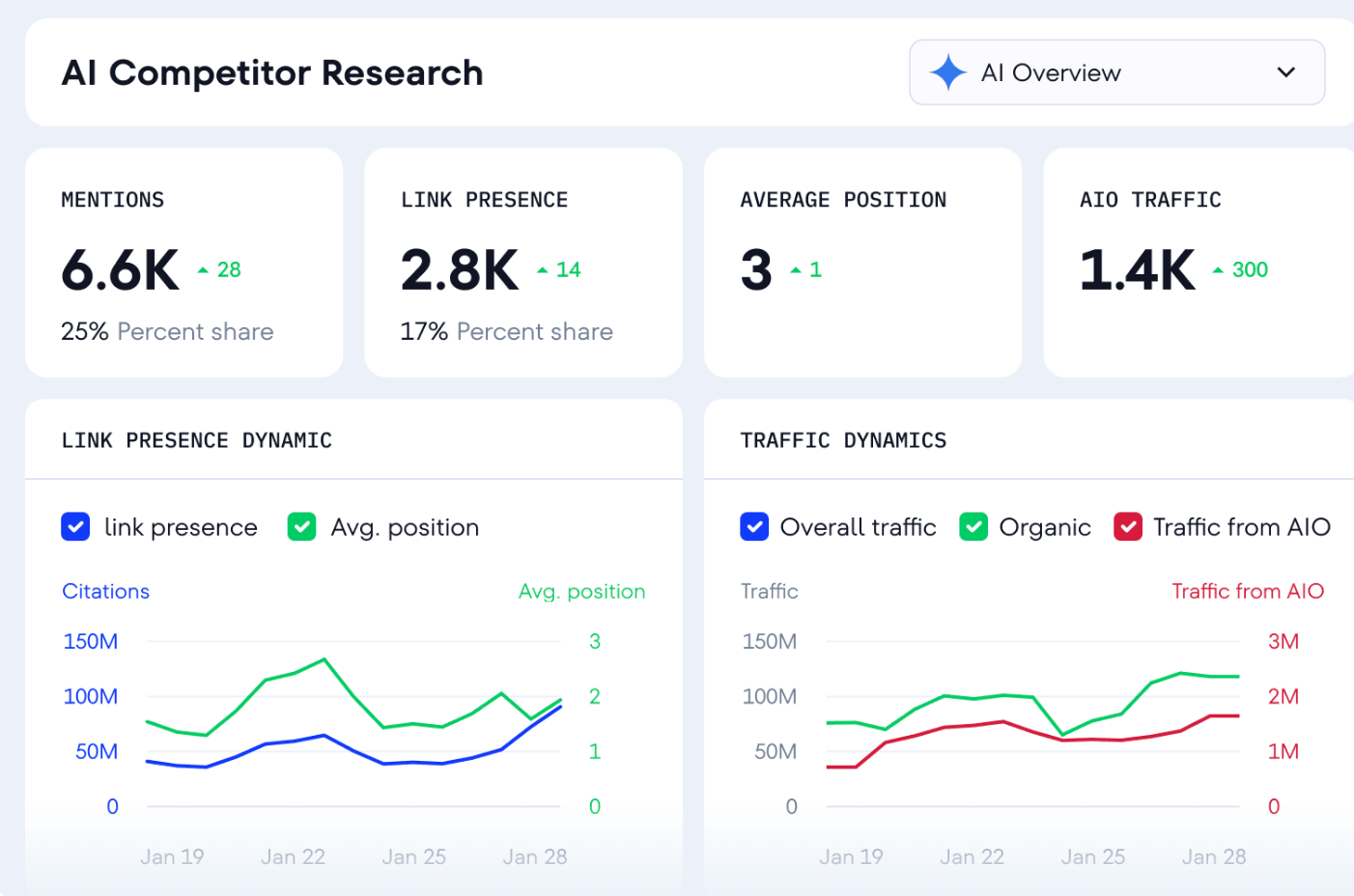
Pros:
✅ Integrated directly into SE Ranking, no separate setup required
✅ Historical visibility data available depending on plan
✅ Weekly reports and visual charts
Cons:
❌ Supports only ChatGPT (no confirmation of other LLMs)
❌ AI module available only as a paid add-on
❌ No public API or raw AI response export
SE Ranking’s AI Visibility Tracker is a convenient option for users relying on the platform for rank tracking and audits. It gives a basic overview of how a brand appears in ChatGPT but lacks the depth and flexibility of specialized LLM tracking solutions.
5. Nightwatch
Nightwatch is an SEO and rank-tracking platform. In addition to its classic SEO features, rank tracking, site audits, and automated reporting, Nightwatch recently introduced an AI and LLM Tracking module.
This feature lets users monitor their brand’s appearance in AI-driven search results and large language model responses, including ChatGPT and Claude. It visualizes visibility changes over time and shows which competitors are most often cited across key prompts.
The feature is still in beta and is currently available for higher-tier plans.
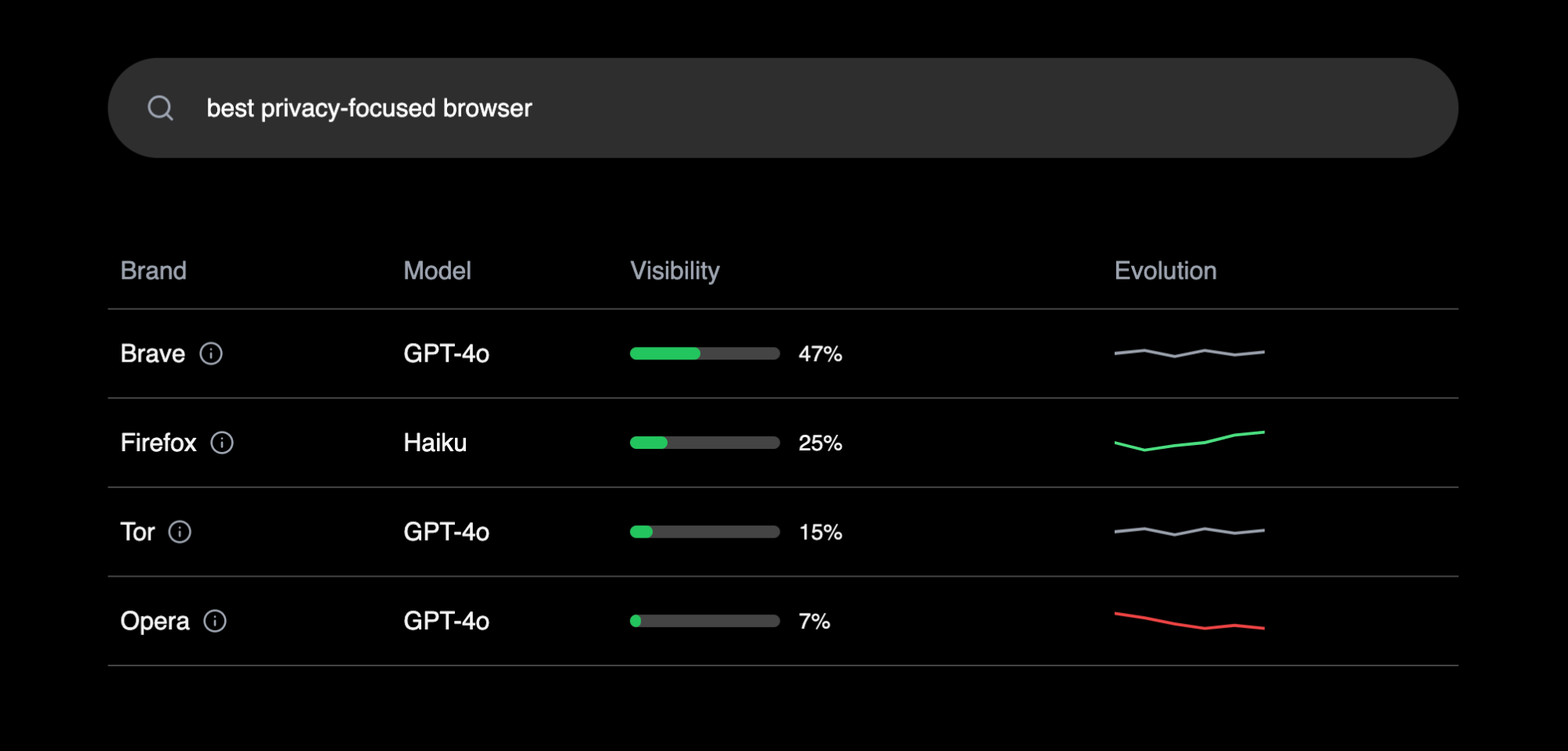
Pros:
✅ Tracks brand visibility in ChatGPT and Claude answers
✅ Integrated directly into Nightwatch’s SEO dashboard
✅ Includes daily keyword tracking
Cons:
❌ AI Tracking is still in beta, not included in Starter plans
❌ No public API or raw AI response export
❌ Lacks deep citation or prompt-level analytics
Nightwatch is an established SEO platform that recently introduced an AI Visibility module. The feature allows users to monitor brand mentions within ChatGPT and Claude responses and view visibility changes over time. At the moment, the module tracks only a limited number of models and does not include citation data or raw response export.
Conclusion
LLM visibility tracking is becoming as essential as Google rank tracking. Sitechecker stands out as the most advanced and practical choice among all tools. It combines prompt-level analytics, citation insights, competitor comparison, and historical visibility, all in one dashboard. While it currently tracks ChatGPT and Gemini, broader LLM coverage is on the roadmap.
Other tools like LLMrefs, RankLens, SE Ranking, and Nightwatch offer partial or beta-level visibility but lack depth and usability. If you want a clear, data-driven view of how your brand appears in AI answers, Sitechecker is the best LLM Visibility Tracker.
What’s the difference between LLM visibility and AI overview tracking?
Can LLM visibility replace traditional SEO metrics?
How can agencies improve a client’s LLM visibility?
What are the best KPIs for LLM visibility?
- Share of voice in AI answers (percentage of mentions vs competitors)
- Citation frequency and position
- Brand recall rate across prompts
- Trend of visibility over time
These KPIs reveal whether the client’s authority inside AI systems is growing, stagnating, or declining.
